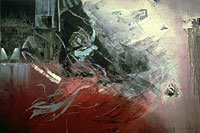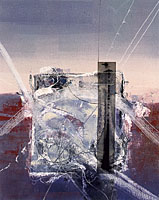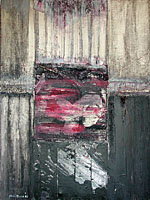Chris' approach and technique
You've been an artist for over forty years now and you've
seen a great deal of change in the art world. What does your
experience lead you to describe what an artist is?

The personal expression of art is the dreams and reality from
the psyche of the artist and relation to personal autobiographical
material and the world around us.
How do you define the difference between arts and crafts
then? What is Art with a capital A?
There's a very fine line of demarcation between arts and crafts.
Part of it has to do with historical content of the art. What
survived through the ages were crafts, pots, sculptures and cave
paintings. These objects found in archeological excavations become
art. So art is what we actually elevate to an artform. When you
talk about crafts or utilitarian objects, art is not utilitarian.
It's not supposed to be utilitarian, but at many times it transcends
utilitarian objects and turns into art objects in the way we
perceive it.
Is there a distance then between art as decoration and
art as meaning?
Definitely. There is a decorative art which steers us to one
journey for its beauty but it doesn't have the intrinsic quality
of substance which true art has.
So what makes great art then? What makes a piece of art
a great work of art?
Only time can tell the great art because there are many artists
we admire now--incredibly great artists--but in their time they
were not considered great artists, so it's a subjective evaluation
that you make. Time is one component. The act of art creation
is important as well, whether the artist creates an object purely
for "sale" or whether it is motivated by the inner
passion of the artist. And there is the difference. When you
consider the artist's creation as commercial, then accordingly,
you pass much of the creativity out the window, it's no longer
a piece of art. It's a purely commercial object and it could
be created in a factory as well. It doesn't have to be done by
a single artist.
So one thing that distinguishes great art is that it transcends
commerciality and you can only see it over a long period of time.
That's correct. Art created solely for commercial purposes
is not art in its immediacy.
Your personal history includes experience in industrial
design, fabric design and textiles, and graphic design. You have
formal training in design fundamentals as well as art. How come
you became a painter?
I did not choose it. I think the art chose me. I was trying
to do a lot of things done by commercial artists and fine artists.
I was also trained as a teacher. I love to teach but art holds
the reins with me. It's a compulsion.
What is it about painting that you enjoy so much then?
The greatest satisfaction is actually in creating and doing,
and it really doesn't matter what happens afterwards. I did sculpture
in college at Pratt Institute. I studied three dimensional design,
but it was never really my strength. I like to create three dimensions
on a flat surface. What fascinates me is the illusion of space.
|
Why oils?
Oils have proven stable through the ages and they never lose
their luminosity, their tactility, their value. The enjoyment
of working with oils doesn't compare to any other materials that
I've used. I also do watercolors but not to the same extent as
the oils. Oils are everlasting. When I use oils on paper, there
is a specific quality which allows me to use layers of paint,
one over the other, and there's immediacy to it which you don't
have on canvas. For me, paper has many more possibilities than
you have on canvas. It's not as limiting.
|

Force de la Mer Diptych, 1978 |
One of the interesting things about your work to me is
that on a certain level your work is very finely detailed and
intimate yet many pieces have a tremendous amount of strength
at the same time. The Force
de la Mer pieces where you can get up right next to it and
it's this beautiful, close-up, intricate patterns and interplay
of color and then stand back and be washed away with it's tremendous
power. The Prometheus
pieces as well. How do you account for that duality?

Prometheus II, 1989 |
It's very hard for me to account
for the duality of it. I'm not conscious that I'm putting a lot
of detail into it. When I work on a large canvas I use my entire
body, my arms swing, I move everything. So that gives you the
movement and the strength and then I do a quite a bit of calligraphy.
You know, I love to do calligraphic writing and incised intaglio.
I carve lines into the paint and I draw by carving out lines.
I think that provides the extra detail that you are mentioning.
I oftentimes use other objects like film. Then I underpaint and
overpaint and juxtapose over the paint, so there is addition
and subtraction--almost as if an etching was evolving. I apply
layers of paint--I underpaint and overpaint and then incise into
it. There is an element of surprise in it. |
Throughout your artistic career you've had a great number
of different series. Some come and go. Others recur. Where do
these themes come from?
They usually begin with some sort of observing experience
in my life either through travel, literature, or observing what
is happening around me. This stimulates me and has an impact
on my creativity. I begin with one or two pieces, and then explore
further if I enjoy the series. When I reach a point when I'm
not enjoying it anymore, there's no more to say, I stop. I do
not like to repeat myself.
Do you have some favorite themes?
The voyager. I've returned to this theme several times in
the Ancient Mariner
series and the Voyager series,. My Apocalypse series is
a recurring theme because of my war experiences, including a
large number of pieces based on the Never Again theme.
The Ancient
Mariner and the Voyager series have to do with
travel around the world and space exploration. There is a universality
to these sorts of exploration because they're not only physical
explorations but also emotional and mental explorations. The
Ancient Mariner,
in a way, represents the historical aspects of exploration. The
Voyager series has to do with the space probes and accepting
the fact that we are just a small speck in the universe. We consider
ourselves so important on Earth but we're really not a very important
part of the greater universe.
|

Ancient Mariner I, 1980 |
Do you see, do you use your art as a form of exploration?
Do you see yourself as an explorer and a voyager?
Yes, in a way I travel too. I get involved in my own work
very much. I almost walk into it either with canvas or paper--I'm
part of it. When I work, the rest of the world disappears and
I'm not really consciously aware of what comes out of the studio.
A part of me steps back and another part takes over. That duality
is there all the time, but when I work, it shifts its balance.
I forget about time, space, where I am, and who I am. It transcends,
I would say, my regular, normal experiences. Oftentimes when
I walk into the studio and nothing comes out, it's because I
have not reached that point when I can leave the world outside
and be able to concentrate and tap on my inner resources and
strengths.
If one had to categorize your work, it most closely falls
into "abstract expressionism." Why is that? What is
it about that movement that communicates so much to you?
There is a good explanation to that question. I was growing
up and being trained as an artist at the time in New York where
abstract expressionist took over the art world. New York was
then the center of the art world and the abstract expressionist
painters were in the forefront. The professors that I studied
under were the movers and shakers and innovating the notion of
art through the abstract expressionist movement. It was a gestural
type of movement based on pure creativity and color theories
and it had very little to do, again, with a conscious effort
the previous centuries were exploring in art. This was really
the nexus of the twentieth century expression in art and this
was one of the richest periods in artistic development. There
are many movements that came out of impressionism. We had pointillism
and that went into cubism, and from cubism it went into all the
different -isms. I was therefore influenced by what surrounded
me and how I was trained as an artist. Hans Hofmann, Josef Albers,
Max Ernst, Jimmy Ernst, and James Brooks were my professors at
Pratt Institute, and when I went to the galleries and museums,
basically that's what was shown. So I'm very much a reflection
of those times.
How has our abstract expression evolved since then?
All artists grow and develop--they evolve. I've become interested
in so many other things beyond just pure forms and color and
shape--especially in relation to the content. As my work has
evolved, it has become more content-oriented where before it
was just pure form and shape. Abstract expressionism became more
meaningful to me to become some expression of my life. My work
is based on everyday occurrences, readings, experiences, contacts
with individuals, and traveling to different places. All of this
has a great impact and forms me as an artist. I don't find myself
sticking to one formula. In fact, I don't like doing formula-type
art. When something becomes too well accepted, I really don't
want to do it any more. It becomes too easy.
It seems that your work, in particular, and abstract expressionism
as a movement evolved to become not just more content-oriented
but that emotions have became more important as well.
That's true. And you find that the art world in itself
also has gone through the same changes. We've moved away from
the pure abstract expressionism into more content, more historical
art, more descriptive art, and social commentary. We also have
accepted other forms of art which we did not before, like photography.
And then of course there is computer art which is still in an
infant stage, and that's coming. Obviously, for the next millennium
we're going to have different kinds of art forms and art evolving.
Then you won't have the conflict between the machine and the
computer versus the creative artist situation. There's going
to be convergence. There's going to be a marriage between the
two. That's just the way I perceive it. I also perceive that
some of the invisible material which were not visible to a naked
eye before, to an artist, now is visible. We can see into a cell.
We can see into DNA structures. We can see with lasers. We can
see into the stars and beyond the horizons, beyond the greater
Universe. All of this has an impact on creativity.
|

Nucleotides I, 1984 |
Technology is the basis of many of your series--especially
the DNA (or Bio) series, the DRAM series, etc.--but it also shows up
in other ways throughout some of the other pieces as well. What
was the genesis of the DNA series?
Well it really has to do with my daughter's profession.
She studied molecular biology and genetics and she's now teaching
genetics and immunology. Her work in the field and the possibilities
of what is going on in the previously invisible parts of organisms
captured my attention. Whereas before we could only think and
conceptualize, now we can see. That stimulated me and I began
using the materials which were then available to me from the
laboratories of Stanford, Harvard, and the Institute de Pasteur.
Actually, the scientists that provided me with the materials,
in a way, challenged me to do something with these materials
so I incorporated them right into my work and the DNA
series began. In the DRAM
series I was stimulated by a friend who was an engineer at Hewlett
Packard and he brought a box of rejects (as he called them) of
computer boards. I saw the similarities between the computer
chips and the DNA autoradiograms. I could intuit some kind of
link between the two sciences and, of course, they're now beginning
to converge, the computer and biotech industries. As an artist
I perceived a convergence many years ago and it was very exciting
for me to see it happening now. We still don't know what will
evolve from it.
|

DRAM III, 1989 |
You seem thoroughly optimistic about these technologies
even though you have a couple of pieces like Pandora's
Box which is more playful than pessimistic. You also seem
very optimistic about the future...
Oh yes. I feel that humanity will survive and we
will evolve into a better species due to technological advances
and biotechnology. We need to protect our environment and to
stop the wars and fighting--the self-destruction. We must appreciate
what is really of greatest benefit to humanity: art, music, science,
knowledge, literature, etc. Without the arts, without the technological
advance to combine with our arts, and what passes on from generation
to generation, I think we're doomed. If we leave everything to
politicians and people with no vision and no creativity, the
human race is not going to survive. But I am very optimistic
that we will survive because of the creativity that I see in
human beings.
|

Pandora's Box II 1984 |
Is this why you've chosen to live here in the San Francisco
Bay Area where there is almost nothing but optimism about technology
in the future?
Well, I have chosen to live here for the sake of the intellectual
activity which is available here, the intellectual stimulation
that we get from friends, and the overall ambiance of music,
art, and thinking in the universities and companies. This is
a very, very important place to be at this moment in time. I
don't know how long it will last because knowledge of history
makes me doubt that it will last forever--nothing is forever.
Rome has disappeared, Athens has disappeared...
Florence is still there.
Florence is still there because where there is art, there
is life. When you see what's really survived over centuries,
what passes on, it's art and music. When we go to museums we
face what has survived from societies through history and that's
why say the utilitarian objects are being elevated to art forms.
They're putting them on pedestals, and everything else (like
money) is so transitory. Civilizations come and go but we do
pass on from generation to generation the acquired humanity.
This is the truth of humanity--what makes us different from the
animal kingdom.
So are we passing on from generation to generation the
appreciation of art and the perspective that art is important?
Well, I hope so but the problem is with art education. I'm
involved now in volunteering as an art teacher. I go into the
classrooms and spend time with young people from first grade
on and do whatever I can. But there are not enough artists volunteering
on a steady basis. You need art and music education in schools,
which is lacking now. We're creating troubled human beings. We
are training in technology, in math and science but creativity
is a requirement for the visionary people who are responsible
for the continuation of these endeavors. That's where I feel
art and music have tremendous roles to play in educating our
children and young people. And that's what is lacking at the
moment. Hopefully, it will change.
Home | Catalog
| Biography | Exhibits
| Timeline | Interviews
| Studio






